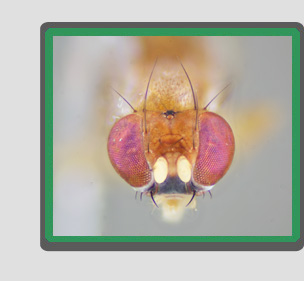| |

Characteristics & Similar species
The Clusiodes melanostomus complex is widespread in North America and is one of the most frequently-encountered groups of Clusiidae. Species in this complex differ from other nearctic Clusiodes by having two pairs of dorsocentrals (not three), a black male face (at least above the buccal cavity, hence the name), a shiny (not pilose) ocellar tubercle, an apically cleft surstylus, and pale overall colouration with variable striping on the thorax. The pale colouration alone distinguishes almost all members of the C. melanostomus complex from the remaining Clusiodes with two pairs of dorsocentrals. The dark C. eremnos Caloren & Marshall (British Columbia, northwestern United States) is an exception to this rule, but its mostly yellow legs, shiny ocellar tubercle and characteristic genitalia mark it as a member of the C. melanostomus complex.
Males of many species in this species group have long, stout and flattened male vibrissae. Similar vibrissae appear independently in other species groups (in Clusiodes johnsoni Malloch and the European C. pictipes (Zetterstedt), for example) but the male vibrissa of C. melanostomus complex is often especially large and elaborate. The anterior genal bristle is also enlarged and vibrissa-like in C. gracilolobus Caloren & Marshall and the palaearctic C. pictipes, although the latter species has both "vibrissae" relatively straight, not curved. Some males in this complex have unmodified vibrissae, particularly in the northern part of the range, and some have the vibrissae only slightly thickened (as figured above).
Relationships within the complex
The species presently described in this complex are here only tentatively accepted, as most of the superficial characters traditionally used to define these species do not hold up to scrutiny across, or sometimes within populations. Intermediates between putative species are common, and only rarely does a single character (or combination of characters) hold up as diagnostic for a single species. Colour pattern, chaetotaxy, vibrissal strength and number, and even characters of the genitalia, fail to consistently diagnose most currently recognized species in this complex, and most members of the complex seem to intergrade with other species along both longitudinal and latitudinal gradients. For these reasons we have decided to treat this complex as a single unit until we can be more confident of species boundaries within the group.
Caloren & Marshall (1998) include descriptions and illustrations of the seven species currently included in this group (Clusiodes melanostomus (Loew), C. spinos Caloren & Marshall, C. eremnos, C. leptadodemus Caloren & Marshall, C. coconino Caloren & Marshall, C. gracilolobus Caloren & Marshall and C. clandestinus Caloren & Marshall).
Distribution
The Clusiodes melanostomus complex is widespread in North America, and although it is not known from the interior of the continent, this is likely only a collecting artifact. The closest relatives of this group form a single clade endemic to eastern Asia (Lonsdale & Marshall, 2007b). |
|
 |